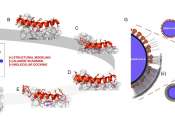Severe Acute Respiratory Syndrome (SARS; pronounced /sɑrz/, sarz) is a respiratory disease in humans which is caused by the SARS coronavirus (SARS-CoV). There has been one near pandemic to date, between the months of November 2002 and July 2003, with 8,096 known infected cases and 774 deaths (a case-fatality rate of 9.6%) worldwide being listed in the World Health Organization's (WHO) 21 April 2004 concluding report. Within a matter of weeks in early 2003, SARS spread from the Guangdong province of China to rapidly infect individuals in some 37 countries around the world.
Mortality by age group as of 8 May 2003 is below 1% for people aged 24 or younger, 6% for those 25 to 44, 15% in those 45 to 64 and more than 50% for those over 65. For comparison, the case fatality rate for influenza is usually around 0.6% (primarily among the elderly) but can rise as high as 33% in locally severe epidemics of new strains. The mortality rate of the primary viral pneumonia form is about 70%.
As of May 2006[update], the spread of SARS has been fully contained thanks to the efforts of the WHO, with the last infected human case seen in June 2003 (disregarding a laboratory induced infection case in 2004). However, SARS is not claimed to have been eradicated (unlike smallpox), as it may still be present in its natural host reservoirs (animal populations) and may potentially return into the human population in the future.




